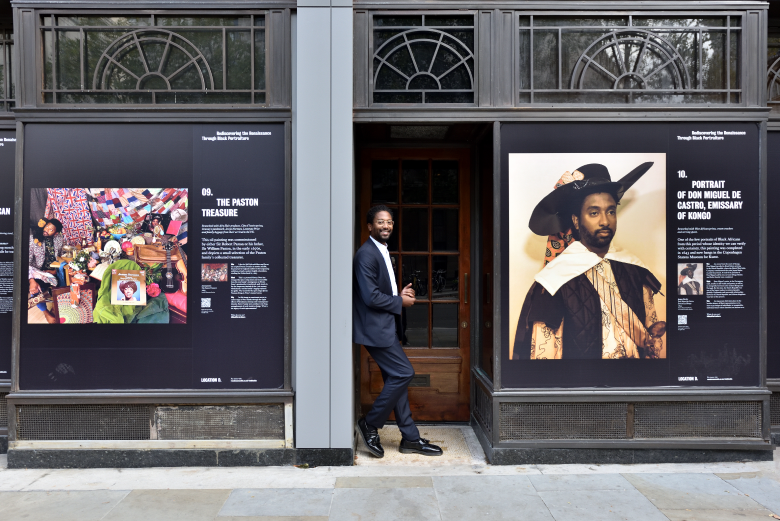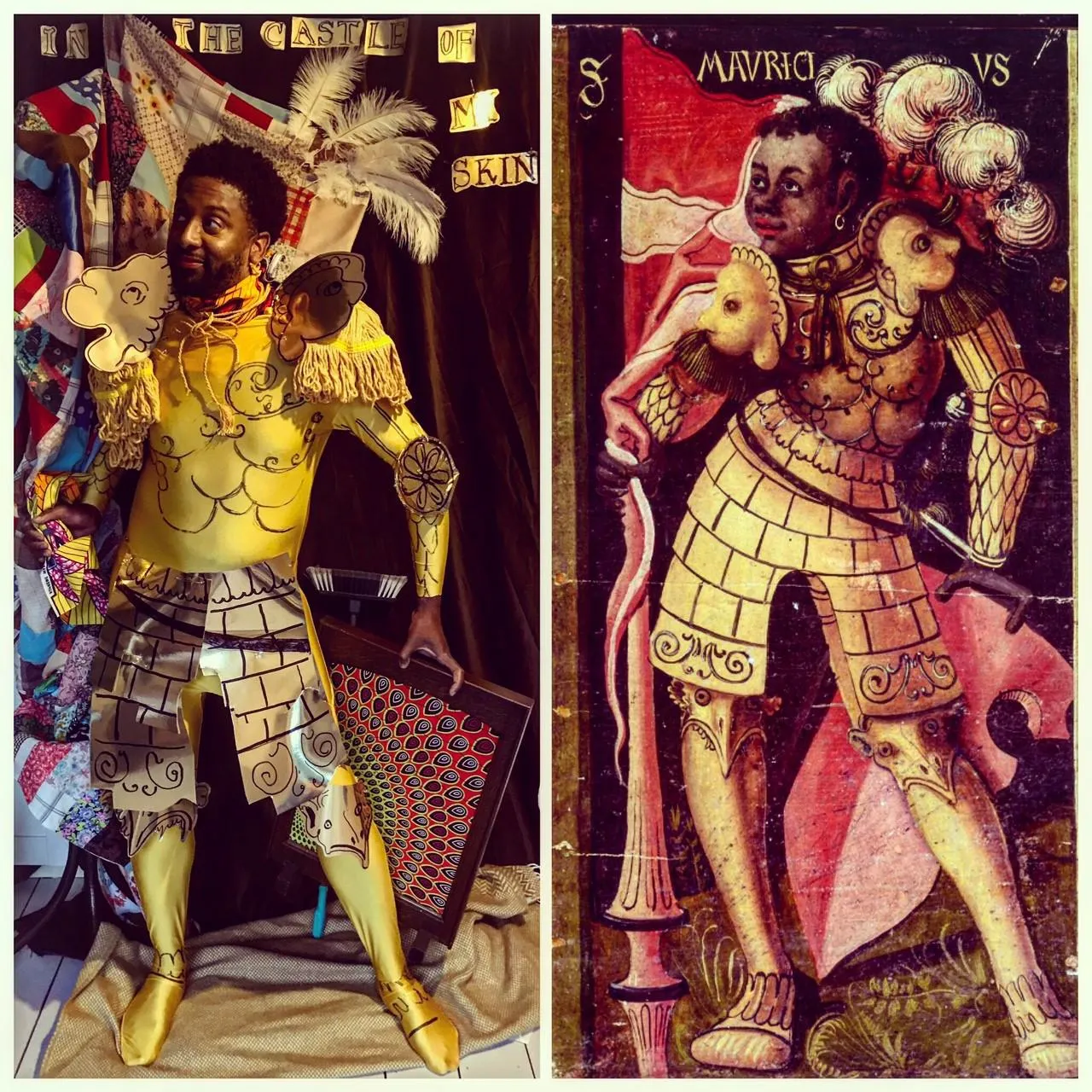Rediscovering Black Portraiture is about platforming less dominant voices - specifically the Black lives silenced by the canon of Western Art. My collaboration with the Renaissance Skin research team at King’s College London represents some of the stories and lives that have remained hidden from view. I hope Visible Skin can start a dialogue that allows us all to speak about a past that is often avoided in the present.
Peter Brathwaite, opera singer and broadcaster
30 November 2021
Visible Skin exhibition extended until February 2022
Visible Skin: Rediscovering the Renaissance through Black Portraiture, King’s outdoor exhibition on the Strand, has been extended until 18 February 2022 due to popular demand.

Part of the launch programme for Strand/Aldwych, a new public space in London, Visible Skin, which showcases the work of artist Peter Brathwaite in collaboration with King’s Renaissance Skin research project, has been seen by thousands of pedestrians on the Strand since the exhibition opened in September. It has received wonderful press reviews, with TimeOut London recommending it in October as one of the most inspiring things to do in the city for Black History Month.

Today the Renaissance is remembered as a time of cultural ‘re-birth’, a flowering of the arts that gave rise to artists such as Michelangelo and Leonardo and enshrined new ideals of beauty. A still largely unexplored facet of the Renaissance is the diverse, multicultural European life represented in its art, particularly the representation of Black individuals. Portraits and images of Black people abounded in the Renaissance. They included portraits drawn from life as well as a wider cast of imagined Black identities such as biblical subjects, saints and allegorical figures.

Starting in the first COVID-19 lockdown, the opera singer and BBC broadcaster Peter Brathwaite embarked on a Twitter project as part of the #GettyMuseumChallenge: restaging famous paintings with everyday household objects. Peter restaged works that focused specifically on Black portraiture, using items from his family’s past, and from his cultural heritage in Barbados and Britain.
Working with researchers from King’s Renaissance Skin project and King’s Culture, 11 photographs from this series will be shown from 10 September in windows across King’s Strand Campus, as part of Westminster City Council’s launch of a pedestrianised Strand, a new public space in London.
All 11 images will also be displayed in an online gallery accompanied by audio interpretation clips by Peter and curator Dr Hannah Murphy, Renaissance Skin Co-Investigator. Supported through a Wellcome Trust Diversity & Inclusion grant, a key objective of the exhibition is to focus on engaging diverse audiences and expanding perceptions of Black identities in the study of the Renaissance.
The images in this exhibition not only testify to the presence and prominence of Black life in Renaissance Europe, they also mirror its complexities. European countries had a long history of trade and diplomatic contact with African kingdoms. From the 1440s onwards the trade of enslaved peoples began to overlay this longer history. But not all Black or African people in Europe were enslaved or connected to slavery, nor were all Black people African. Princes and diplomats, Black travellers, merchants, emissaries, performers, clergymen, and skilled craftsmen all appear in the records, and the visual art, of the Renaissance.
As a historian of the Renaissance, I was immediately struck by the significance of Peter's project. Scholars have been searching for traces of Black lives in the archives for years. Peter's artworks ask us to look past the silences of historical record, daring us to reimagine the diversity of our shared heritage and history, and to find new possibilites in the past. His restagings are joyful, exuberant and important, and we are thrilled to bring them to life at King's.
Dr Hannah Murphy, UKRI Future Leaders Fellow & Lecturer in Early Modern History at King’s College London and Visible Skin curator
In the larger project, Peter has reimagined not only Renaissance images but representations from the 11th century to the present day, daring viewers to consider how people of colour have and should be seen and portrayed. His work brings to the fore the contemporary importance of historical presence – turning this collection of images from a meditation on the past to an interrogation of the present.
Skin is the most visible part of our bodies – sometimes we ignore it, many times we define and categorise it. It has been a privilege to work with Peter Brathwaite and Hannah Murphy, Lecturer in History at King’s on Visible Skin, an exhibition inspired by our Wellcome Trust funded in-depth research on Renaissance Skin. Brathwaite’s photography asks us to look again at the visibility of race in the Renaissance period in Europe. We hope this intervention in the public spaces around the Strand will provoke comment, dialogue and discussion.
Evelyn Welch, Professor of Renaissance Studies and Senior Vice President Service, People & Planning at King’s College London
The launch of the exhibition was celebrated on 1 October in a special Q&A event with Peter Brathwaite and Farah Karim-Cooper, Professor of Shakespeare Studies at King’s and Co-Director of Education at Shakespeare’s Globe.

Visible Skin - Rediscovering the Renaissance through Black Portraiture
10 September 2021 – 18 February 2022
King’s Strand Campus
www.renaissanceskin.ac.uk/visibleskin
@RenSkinKCL @CulturalKings
#BlackPortraiture
Acknowledgements:
Sam Baldock – Photography
Wiedemann Lampe – Exhibition design
King's Digital Lab – Website design
The Shoots Group – Audio production
Image/lender credits:
Rijksmuseum; Germanisches National Museum; Statens Museum for Kunst; National Gallery of Ireland; Gemäldegalerie der Staatliche Museen zu Berlin; Wellcome Collection; Museum of the City of Brussels; Norfolk Museums Collections; Carlton Hobbs LLC; Bridgeman Images
Thanks also to:
Professor Toby Green; Canon Peter Babington, Priest-In-Charge at St Mary le Strand; Sarah Guerra and the Equality, Diversity & Inclusion team at King's.


